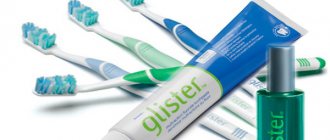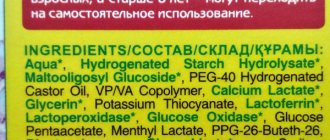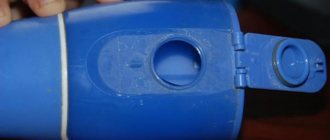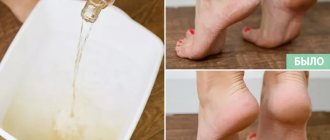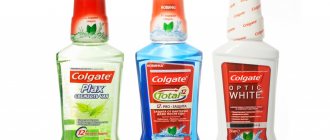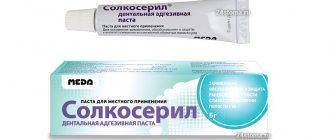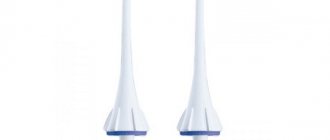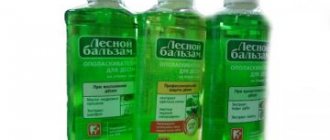Compound
The medicine in question is oily and concentrated, and has a pronounced menthol taste.
The medicinal effect is determined by the presence of an active concentrate in its composition:
- Cetylpyridinium chloride. Provides a strong anti-inflammatory effect, while also having high-quality antiseptic properties. Its presence ensures instant destruction of pathogenic microorganisms. The same substance is part of another drug, Septolete.
- Poloxamer 407. A cleansing component, its presence ensures the elimination of dental plaque and other deposits. The composition is surface-active and can remove even stubborn plaque.
In addition to the indicated active substances, the drug contains additional components:
- water, which serves as the basis of this medication;
- glycerin, which forms an invisible film and acts as a protective layer;
- ethyl alcohol, which plays the role of an antiseptic, ensures instant penetration of all components into the tissue;
- emulsifier polysorbate, which has easy cleansing properties;
- sodium saccharin, used as a common sweetener;
- menthol, which performs the basic properties of external anesthesia;
- food synthetic coloring additives.
Release form
Release options are established by the manufacturer directly during the production of this product. The most common types are noted as follows.
Toothpaste
Toothpaste tubes come in 50, 100 and 150 milligram varieties. Placed in cardboard boxes, there are no instructions for use in practice.
Spray
The spray is available in aluminum tubes with a capacity of up to 180 milliliters. Placed in cardboard boxes and supplied with an instruction manual.
Also included in the package is a dispenser for practical convenience.
If necessary, the manufacturer can develop packaging with a larger capacity
Rinse aid
The rinse aid is produced in containers made of glass or aluminum with a volume of up to 250 milliliters.
You can carry out up to 500 rinses from the largest capacity container. In addition, this composition can be used to prepare liquid for rinsing.
The bottle is equipped with a dispenser. Provides ease of use. You can use it every day only by diluting the composition.
Series “GLISTER™ Oral Care”
GLISTER™ Dental floss Code: 0994
289 rub.
375 rub. Volume: 30 m
GLISTER™ Universal toothbrushes Code: 100957
670 rub.
870 rub. Volume: pack/4pcs
GLISTER™ Oral freshener spray with mint scent Code: 120351
273 rub.
355 rub. Volume: 12ml/9g
Glister™Kids Toothpaste for children Code: 120519
243 rub.
315 rub. Volume: 65 ml/85 g
Glister™Kids Toothbrushes for children Code: 120522
516 rub.
670 rub. Volume: pack/4 pcs
GLISTER™ Multifunctional toothpaste, travel size... Code: 1959
169 rub.
220 rub. Volume: 50ml/75g
Glister™ Kids Oral care for children Code: 303336
901 rub.
1170 rub. Volume: 1 set
Glister™ Comprehensive oral care Code: 303558
RUB 1,743
2264 rub. Volume: 1 set
GLISTER™ Multifunctional toothpaste Code: 6833
370 rub.
480 rub. Volume: 150ml/200g
GLISTER™ Concentrated liquid for rinsing... Code: 9949
608 rub.
790 rub. Volume: 50ml
Amway glister™ oral care
Oral care is extremely important not only so that you can smile a snow-white smile and feel confident. This is necessary for the health of the entire body. About 50% of the population believe that a smile is the main distinguishing feature of any person. The average woman smiles about 62 times a day, while the average man smiles only 8 times. Children smile most often - about 400 times a day. We need teeth to chew food, speak, and are indicators of our overall health. Our goal is to help you take proper care of your teeth and entire oral cavity.
An important factor is: Oral hygiene and prevention of diseases of teeth and gums. Oral hygiene is the daily procedure of brushing your teeth using an Amway toothbrush and floss, which help maintain the health of your teeth and gums and prevent their diseases.
Effective, systematic oral care can significantly reduce the risk of gum disease. Brushing your teeth daily with Amway toothpaste and using Amway dental floss, eating well, and visiting your dentist regularly are very important for healthy teeth and gums.
The secret of a dazzling smile
Did you know that tooth enamel is the densest tissue in the human body?
It consists mainly of inorganic substances and protects itching from mechanical stress. Poor nutrition and poor oral hygiene can lead to enamel damage and tooth decay.
It all starts with plaque, a film that forms on the teeth and contains many bacteria. If plaque is not removed regularly, it can lead to a number of dental and gum diseases. If it is important for you to maintain healthy teeth and strong enamel, visit your dentist regularly and, if necessary, undergo hardware teeth cleaning and tartar removal procedures. Also take care of regular oral care at home: toothbrushes, toothpaste and floss are excellent helpers in maintaining healthy teeth and gums.
How to brush your teeth correctly
A third of people brush their teeth for just 45 seconds instead of the two minutes recommended by the British Dental Association. Meanwhile, brushing your teeth with fluoride toothpaste twice a day for two minutes is an effective way to maintain the health and appearance of your gums. Use a brush with a small, narrow head and soft to medium-stiff bristles. Replace your brushes and your children's brushes every three months as they wear out and become less effective.
Your assistant
The salivary glands produce about a liter of saliva every day. Saliva helps break down food particles during meals and cleanses the mouth afterwards. The process of saliva production slows down during sleep, as well as with age, which, in turn, contributes to the development of various diseases of the teeth and gums.
Did you know that Glister multifunctional toothpaste is Amway's best seller in the European market? Released in 1982, it has remained the leader in sales volume among Amway products for several decades. The effectiveness of Glister toothpaste has been tested in many studies, and all of them have shown positive results with regular use.
Health problems of teeth and gums
Plaque
Plaque is a film that forms on teeth and contains many bacteria. If not cleaned off regularly with a toothbrush or floss, it can lead to a number of dental and gum diseases. When you eat, plaque bacteria convert food sugars into acids, which help demineralize tooth enamel. Ultimately, this contributes to the development of tooth decay.
Dental caries
Dental caries is a disease characterized by the formation of acids on the surface of teeth due to the growth of bacteria in food debris. This leads to demineralization and destruction of hard tissues - enamel, dentin, cement.
When carious tooth damage becomes deep, there is a threat of tooth loss.
Gum disease
Bacteria present between the teeth and on the gums produce acids that can cause redness and inflammation of the gums and bleeding in the inflamed areas. Early stage gum disease, known as gingitis, is a reversible process. It can be stopped by brushing and flossing your teeth regularly. If plaque is not removed promptly, it hardens and turns into tartar, which pushes back the gum tissue, separating it from the tooth, and gradually destroys the bone and periodontal ligament that holds the tooth. Over time, the tooth expands and has to be removed. The best prevention of gum disease is daily oral care, regular dental examinations and removal of tartar, which cannot be removed with just a toothbrush.
Oral hygiene and prevention of dental and gum diseases
Oral hygiene is the practice of brushing and flossing your teeth every day to help keep your teeth and gums healthy and prevent disease.
Effective, systematic oral care can significantly reduce the risk of gum disease. Brushing and flossing daily, eating well, and visiting your dentist regularly are important for healthy teeth and gums.
Why brush your teeth
To maintain a healthy mouth, you should regularly brush your teeth with fluoride toothpaste. This not only helps prevent dental and gum disease, but also eliminates bad breath.
The food we eat contains sugar and starch. When plaque reacts with these sugars and starches, an acid is formed. It affects tooth enamel, which subsequently leads to caries.
Plaque can also irritate your gums. They become red, swollen, painful and bleed. This stage is called gingitis, or the early stages of gum disease. But gingivitis is a reversible process, and with early diagnosis it can be stopped.
If plaque is not removed in time, it can turn into tartar, which contributes to the formation of a pocket between the tooth and the gum; the bacteria in this pocket weaken the bone tissue surrounding the tooth. This can lead to atrophy of the bone tissue around the tooth and, as a result, to the loss of the tooth itself.
How to properly brush your teeth?
You should brush your teeth at least twice a day for at least two minutes. It is better to brush your teeth in the morning after eating and in the evening before going to bed.
After applying toothpaste to the bristles, hold the toothbrush at a 45-degree angle relative to the gums. You should brush your teeth in a circular motion back and forth for two minutes. Remember to also gently brush your gums. (If you press too hard on them with the brush, you may damage them.)
First brush the outer surface of the teeth, then the inner surface, and then the flat chewing surface of the teeth. Use the end of the toothbrush to brush the inside of your front teeth, using gentle strokes away from you. Brush your tongue to remove bacteria and freshen your breath.
Attention! Change your toothbrush every three months. New brushes are better at removing plaque.
How to properly brush your teeth with dental floss
Many people don't realize how important floss is. Flossing is essential to avoid periodontal disease and prevent tooth decay. Periodontal disease is one of the leading causes of tooth loss in adults, but its occurrence can be easily prevented with Amway Glister dental floss. Brushing only removes plaque from the surface of the teeth, so only flossing can remove plaque that accumulates between teeth.
Amway Glister dental floss comes in waxed, unwaxed, flavored, and strip form, and everyone chooses their floss based on their preferences.
Tear off a thread approximately 45 cm long and wrap it around your middle fingers. Pull and pinch the dental floss with the thumb of your right hand and the index finger of your left hand. In a taut state, the thread is inserted into the interdental space, carefully lowered until it comes into contact with the gum (without damaging the gum), pressed against the contact surface of the tooth, and in this position the procedure is performed.
5-6 movements in the anteroposterior direction towards the cutting edge. The thread is advanced carefully so as not to injure the gums.
Without removing the floss from between the teeth, wrap it around the adjacent tooth and rub it as well.
After use, unwind the required length of clean thread, and wind the used part around your middle finger. Floss each tooth on both sides. Be sure to floss the back of your back teeth on each side of your upper and lower jaws. After this, rinse your mouth thoroughly with water.
People who are not comfortable holding floss with their little ones can use a special floss holder or other devices. These include special brushes, toothpicks and sticks. Be sure to check with your dentist to ensure you use them correctly and avoid damaging your gums.
Why is it important to rinse your mouth?
Many people know how important it is to brush their teeth daily. However, they do not know that rinsing your mouth is equally important. The rinse not only removes plaque - it also strengthens the enamel and protects teeth from caries. The rinse cleanses those areas that are inaccessible to a brush and dental floss - the walls of the mouth, jaw, areas on the tongue and under the tongue. When choosing an Amway mouthwash, study the ingredients and make sure that it contains antibacterial components.
To rinse your mouth, put approximately 30 ml of solution into your mouth. Clench your teeth and rinse forcefully to get the mouthwash into the spaces between your teeth.
Pharmacology
The use of the described substance gives a soft, enveloping effect. Breath is refreshed, and the effect is very lasting.
This occurs after any meal and lasts throughout the day.
The elimination of pathogens in the oral cavity occurs gradually; over time, the elimination of bacteria ensures the healing of all inflammatory processes.
The mouthwash has a universal effect and can be used to treat inflammation in the mouth and prevent their subsequent occurrence.
Advantages
Glister differs from other rinses in some advantages:
- The active substances included in the product reduce the intensity of inflammatory and pathological processes in the oral cavity in 2-3 procedures.
- With regular rinsing with the solution, plaque of any hardness disappears much faster.
- The increased concentration of liquid allows for therapeutic and preventive procedures to be carried out for a long time.
- The pleasant menthol taste makes it possible to refresh the oral cavity throughout the day.
A convenient bottle with liquid and an automatic dose regulator do not cause difficulty or discomfort in use.
The bottle is compact, which allows you to always carry it with you, and if a forced situation arises, use it without prior dilution.
Watch the video about the benefits and use of the product.
Instructions for use of Glister Amway in otolaryngology
In this section of medicine, the remedy is indicated for use in the following cases:
- pathology of gum development of all possible options;
- surface formations on teeth, including various types of plaque;
- traumatic damage to the mucous membrane;
- the occurrence of unpleasant odor from the oral cavity.
Do you want to know how to treat inflammation of the trigeminal nerve at home? Then you just need to follow the link and read our article. You can read about the contraindications of hyaluronic acid injections for the face using the link provided.
Product introduction
Glister mouthwash has a wide spectrum of action and appears to the consumer in the form of a highly concentrated oily liquid with a pleasant and refreshing menthol taste.
The product has a dark green hue, reminiscent of the color of emerald, and is sold in a see-through plastic bottle with a capacity of 50 ml.
Daily use of the drug can cope with:
- with a bacterial coating of solid consistency;
- with signs of an inflammatory process;
- with an unpleasant odor from the mouth.
The drug doubles the effectiveness of pharmacological agents in various fields of medicine.
The product is given the slogan “Approved by the Russian Dental Association”, which becomes a kind of symbol of approval among consumers and guarantees the high quality of the product.
With a runny nose
The most common form of using this medication to treat a runny nose is to use a spray to irrigate the nasal cavity.
It is used by injecting a certain dose of the composition into the nose after regular intervals.
If necessary, the procedure can be repeated over time. The medicine is equally effective both in treating all possible types of runny nose and in preventing it after its occurrence.
The dosage of use and frequency of use are specified in the instructions for use and the recommendations of the attending physician.
Indications for use
Glister is used for the treatment and prevention of diseases and pathological processes of the oral cavity.
In dentistry, the drug has the following indications for use:
- the presence of surface formations on the teeth - cuticle, tartar, pellicle, limescale, soft food plaque;
- pathological processes in the gums of all forms;
- mechanical trauma to the mucous membrane;
- halitosis (bad odor from the mouth).
What is hypertrophic gingivitis and what medications are needed to treat it. Click here to get to know T4k trainers better.
At this address https://dr-zubov.ru/lechenie/bolezni-polosti-rta/prichiny-ploxogo-zapaxa-i-sposoby-ustraneniya.html all about the causes of bad breath from a child.
Side effects
Among the most pronounced side effects of the drug are:
- Irritation of the mucous membrane at the application sites.
- Skin rashes and redness after consumption.
- Allergic reactions.
- Increased heart rate in rare cases.
- Development of an attack of high blood pressure and some difficulty breathing.
- A pronounced symptom of nausea after the patient’s body is incompatible with some components of the drug in question.
Price
The cost of a unit of production is negotiated depending on the form of release of the drug, the markup in a specific distribution location and the manufacturer’s rules.
Depending on all the above parameters, the price of the drug ranges from 100 to 550 rubles per unit of release.
Would you like to see a recipe for homemade depilatory wax made from sugar? Detailed information on this issue is presented here. You can read about the types of removable dentures for the lower jaw here.
You can find out what can happen if a child has a white coating on the tonsils without fever using the following link.
